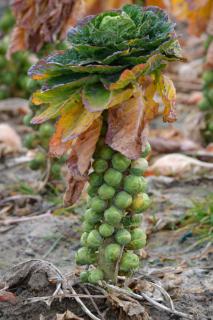

Brussels sprouts are vegetables that are mineral-rich and great for intestinal transit when cooked.
Basic Brussel sprout facts
Name – Brassica gemmifera
Family – brassicas
Type – biennial vegetable
Exposure – full sun
Soil – cool, deep, moist and rich
Sowing – March to June
Harvest – September to March
Productivity – more or less 40 pieces per stem
Special care, from sowing and planting up to harvest, will help you grow magnificent Brussels sprouts.
Brussels sprouts are generally sown at the end of winter or in spring in a sheltered place, to be transplanted outdoors from March to August.
Sow in March and April to harvest in fall and in April or May for a harvest in winter and in spring.
>> More details on timing the sowing to extend the harvest
Sprouting usually happens 8 to 10 days after sowing.

Brussels sprouts love rather cool soil and requires watering on a regular basis in case of dry spells.

The main enemy of Brussels sprouts is downy mildew. Moisture is the primary factor that enables the spread of downy mildew.
Note that Brussels sprouts are also the target of aphids and, of course, caterpillars (the large white is particularly devastating).
For these two parasites, avoid chemical treatments at any cost, because your vegetables and soil could absorb contaminants.
Brussels sprouts are vegetables that are over 90% water, so they only count few calories, and they have high Vitamin C and fiber contents, too. What makes this a particularly relevant crop is the timing: brussels sprouts is a winter source of nutrients.
They also gather many minerals such as potassium, calcium and magnesium.
Finally, the antioxidant lutein and zeaxanthin that it provides help slow ageing.
Brussels sprouts are thus an excellent vegetable that could even help fight ageing and cancer.
Varieties differ in that they’re taller or shorter, more or less productive, and, to a lesser degree, the diversity of their flavors.
Here are a few of the most common varieties:
Provide your cabbage with extra nutrients (fertilizer, manure and seaweed-based compost) to boost growth and especially enhance your own harvest!